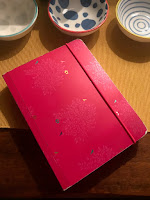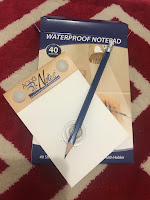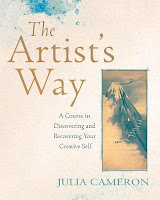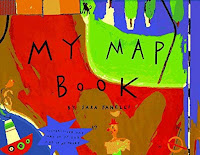The systems we have set up so far:
 Poetry Folder (teal): the shared literature for the class is the daily poem. The poem is read to students, they have quiet time to mark it up (using the questions on the back of the folder as a prompt if required) and the students drive the discussion – commenting on lines that stood out to them, the use of rhetorical devices, the use of diction, form, interesting lines, questions if they are unsure of something or possibly how an aspect of the poem fits in with the rest. At the end of the discussion, students rate the poem out of ten and file it in their folder. Once a semester they compile their top five poems.
Poetry Folder (teal): the shared literature for the class is the daily poem. The poem is read to students, they have quiet time to mark it up (using the questions on the back of the folder as a prompt if required) and the students drive the discussion – commenting on lines that stood out to them, the use of rhetorical devices, the use of diction, form, interesting lines, questions if they are unsure of something or possibly how an aspect of the poem fits in with the rest. At the end of the discussion, students rate the poem out of ten and file it in their folder. Once a semester they compile their top five poems.  I was astonished when reading the class’ Reading and Writing Surveys at how well each student articulated what they like to read, and also, the list of their favourite poets. The students are in grades 7 & 8 – their ages range from 11-14, and they have favourite poets! I think this is incredible and a testament to rich literary worlds they inhabit supported by a range of engaging and enriching poems provided by their teachers and peers.
I was astonished when reading the class’ Reading and Writing Surveys at how well each student articulated what they like to read, and also, the list of their favourite poets. The students are in grades 7 & 8 – their ages range from 11-14, and they have favourite poets! I think this is incredible and a testament to rich literary worlds they inhabit supported by a range of engaging and enriching poems provided by their teachers and peers. Writing In-Process Folder (light blue): containing each student’s Proofreading List, Editing symbols (including ‘STET’ – let it stand), plus the ‘Acorns’ Style Guide so everything can be compiled easily into the quarterly publication. This also helps when compiling shorter anthologies over the course of a trimester.
Writing In-Process Folder (light blue): containing each student’s Proofreading List, Editing symbols (including ‘STET’ – let it stand), plus the ‘Acorns’ Style Guide so everything can be compiled easily into the quarterly publication. This also helps when compiling shorter anthologies over the course of a trimester.
It is astonishing to see student engage in a rigorous writing process. They are empowered and accomplished writers who work their drafts through to be the best version of their piece. It is exciting to join them as they grapple with a line, a word, a title, or a ‘so what?’ as they construct and revise a piece.
Homework Folder (yellow): this folder keeps all homework items together (except Math which has its own sheet in the student’s Math Binders).
Spelling Folder (white): In this folder students have a spelling master list where they add words they have had difficulty spelling across their subjects. They also have a few lists of ‘Commonly Misspelled Words’ to be used as a reference if they are haven’t identified any words from their work. For an outstanding student, there is also a ‘Most difficult words’ type of list. When their writing has been checked mispelled words may be added to the Editing Sheet for students to add to their spelling master list. Every time I read a piece - such as their Reading and Writing Survey, or a Letter-Essay, I also write any mispelled words on a sticky note to be added to the students' master list. Every Tuesday students bring five words written on a Word Study sheet for the teacher to check to ensure that they are not studying incorrect spelling. On Thursdays students partner check and then update their master spelling list with an asterisk if they have successfully shown they know the spelling of their words.
Reading-Writing Handbook: This is a 100-page notebook where students record their Writing Territories, and potential topics for Odes and I also had them write down a few ideas for an anti-Ode as several have already penned an ode. The Reading-Writing Handbook also contains all of the mini lesson notes that are trimmed before class, lists about aspects of a particular genre (such as the Letter Essays).
There are also two permanent folders:
Writing (dark blue): the permanent writing record is where each student files the journey of every piece of writing they do from their W.O.P. (Writing off the Page), Draft 1 with revisions in Blue Pen, Draft 2 with edits in Red Pen (students attach an Editing Sheet to this copy and leave it in the tray), and then teacher edits in Black Pen. Draft 3 is usually a final check just for any grammar, punctuation type things (students leave drafts at this stage on the chair), but if more work is needed there may be another draft and that is okay – it is all part of the process. The final copy is changed to single space and formatted according to the ‘Acorns’ Style Guide. The final copy is paper clipped on top of all of the drafts and then stored in the permanent Writing folder in the cabinet at the front of the classroom. The student records the title of the piece, when they finished it, as well as the genre – a really quick glance shows them (and me) how often they are publishing their writing and what genres they have written in so far.
I have noticed, so far, that students love experimenting with a range of genres, and they have ideas for their next piece whilst they are engaged in writing their current one. There is one student who has set herself a challenge of completing a piece per week. I think this is admirable and her poetry sings a result of a writing process that is considered and thorough.
 Reading (light green): the permanent reading record is where students record the books they have read or abandoned. Students record the date when they finished reading a title as well as the genre. This record allows them to interrogate their reading habits and determine future directions for their reading.
Reading (light green): the permanent reading record is where students record the books they have read or abandoned. Students record the date when they finished reading a title as well as the genre. This record allows them to interrogate their reading habits and determine future directions for their reading.
This is really just a brief overview to reflect and consolidate my understanding of how everything operates at CTL. I have consulted 'In the Middle' and 'The Reading Zone' as well as 'Lessons that Change Writers' and 'Naming the World' extensively. If you are after mini-lesson ideas, check out 'Lessons that Change Writers.'
Picture 1. CTL
Picture 2. Supplies in the Humanities Room
Picture 3. The Writing Room
Picture 4. Folders with two pockets (Staples)
Picture 5. Folders with two pockets and fasteners (Staples)





















